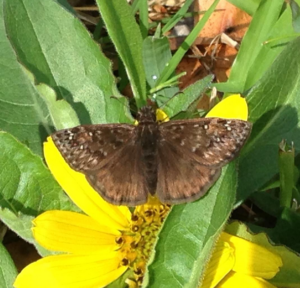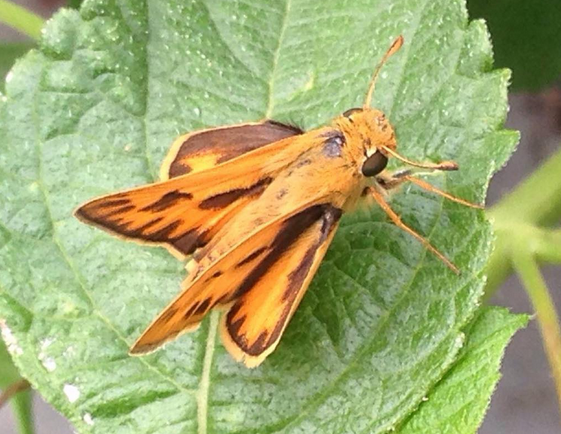Wildlife Wednesday: The Skippers
Spring brings butterflies back to the park, and the Skippers (family Hesperiidae) are one of the first groups to show up. These small butterflies are named for the fast darting manner in which they fly, as if they’re skipping around from flower to flower. There are over 3,500 spp. of skipper around the world, and a couple of dozen of those species are found in the Houston area. Many of the skippers look remarkably similar to each other, and can often be very difficult to identify. Many of the species are also rather drab, being various shades of brown, and can be misidentified as moths (but they are of course diurnal, and have the clubs at the tip of the antennae, which are indicative of butterflies).
Here are a few of the skippers that are found here at the Nature Discovery Center:

Fiery Skippers (Hylephila phyleus) are one of the more common species found here, visiting our wildflower gardens, wildflowers on the front lawn, and the Pocket Prairie. The males are a bit showier, with bright orange and dark brown on the wings (pictured left and top), and the females are a light yellowy brown with brown spots. The tiny greenish caterpillars feed on a variety of grasses, including Bermuda grass and St. Augustine grass. You may notice that this skipper keeps its forewings and hindwings separated at a right angle, with the forewings held up, when it’s resting. This is a small butterfly, measuring only about 1 in long.

The White Checkered Skipper (Pyrgus albescens) is easy to tell apart from most other skippers with its white and dark gray/black checkered pattern. There is however, another checkered skipper that is very similar to this species, the Tropical Checkered Skipper, which is also found in our area. They visit a wide variety of small flowers close to the ground, and their caterpillars feed on a variety of small mallow/hibiscus species, like Sida. They may attain a wingspan of up to 3.8 cm in width.
Juv enal’s Duskywing (Erynnis juvenalis) is one of 2 species of Duskywing (dark colored skippers that keep their wings open and flattened when on a perch), found in our park. The other is the very similar Horace’s Duskywing, though there are many other species of Duskywing across the country. The caterpillars of these skippers feed on oak leaves. They are similar in size to the Checkered skippers, ~3.8 cm wingspan. Duskywings can make themselves rather conspicuous with their darting, climbing, and diving flight patterns, and their habit of sunning out in flat open meadows in plain sight.
enal’s Duskywing (Erynnis juvenalis) is one of 2 species of Duskywing (dark colored skippers that keep their wings open and flattened when on a perch), found in our park. The other is the very similar Horace’s Duskywing, though there are many other species of Duskywing across the country. The caterpillars of these skippers feed on oak leaves. They are similar in size to the Checkered skippers, ~3.8 cm wingspan. Duskywings can make themselves rather conspicuous with their darting, climbing, and diving flight patterns, and their habit of sunning out in flat open meadows in plain sight.
We hope you enjoyed our profile of a few skipper butterflies common to our park. Come out and walk around our wildflower gardens, Prairie Wetlands, and Pocket Prairie, the next time you get the chance, and see if you can spot these delightful little insects.
Thanks so much, and see you soon!
Eric Duran
Staff Naturalist



